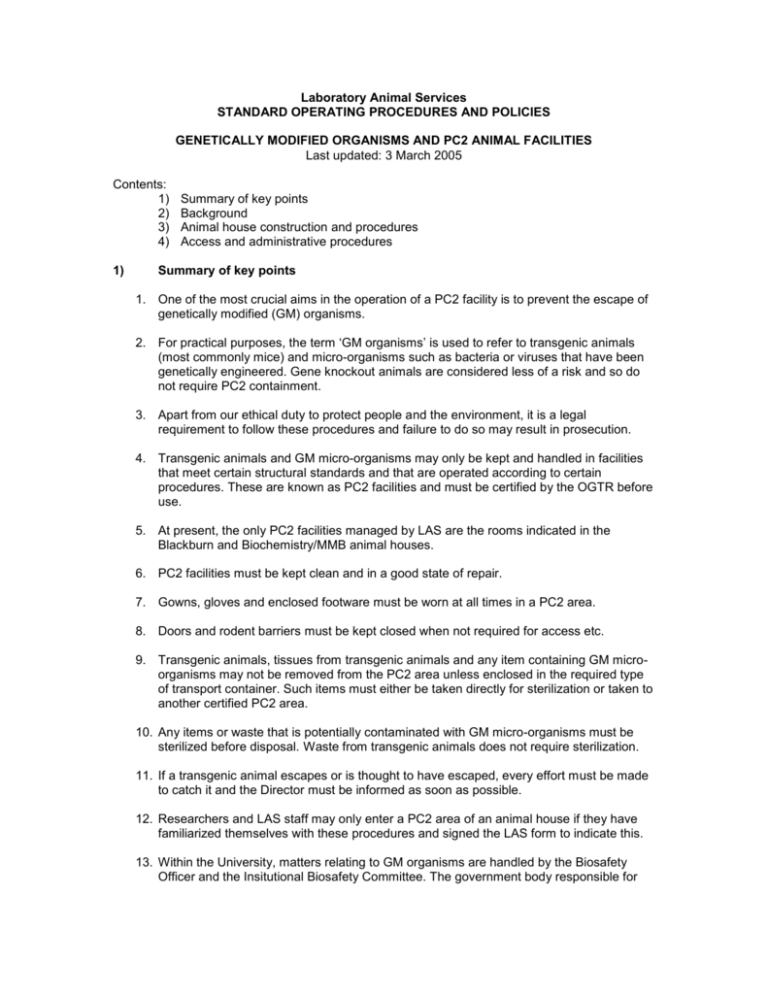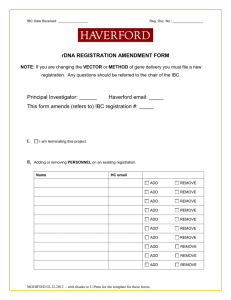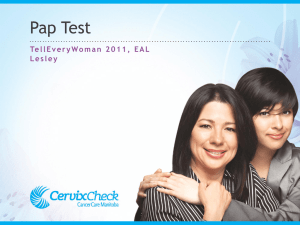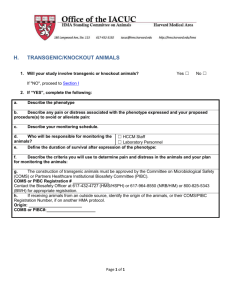Genetically modified organisms and PC2 facilities
advertisement

Laboratory Animal Services STANDARD OPERATING PROCEDURES AND POLICIES GENETICALLY MODIFIED ORGANISMS AND PC2 ANIMAL FACILITIES Last updated: 3 March 2005 Contents: 1) 2) 3) 4) 1) Summary of key points Background Animal house construction and procedures Access and administrative procedures Summary of key points 1. One of the most crucial aims in the operation of a PC2 facility is to prevent the escape of genetically modified (GM) organisms. 2. For practical purposes, the term ‘GM organisms’ is used to refer to transgenic animals (most commonly mice) and micro-organisms such as bacteria or viruses that have been genetically engineered. Gene knockout animals are considered less of a risk and so do not require PC2 containment. 3. Apart from our ethical duty to protect people and the environment, it is a legal requirement to follow these procedures and failure to do so may result in prosecution. 4. Transgenic animals and GM micro-organisms may only be kept and handled in facilities that meet certain structural standards and that are operated according to certain procedures. These are known as PC2 facilities and must be certified by the OGTR before use. 5. At present, the only PC2 facilities managed by LAS are the rooms indicated in the Blackburn and Biochemistry/MMB animal houses. 6. PC2 facilities must be kept clean and in a good state of repair. 7. Gowns, gloves and enclosed footware must be worn at all times in a PC2 area. 8. Doors and rodent barriers must be kept closed when not required for access etc. 9. Transgenic animals, tissues from transgenic animals and any item containing GM microorganisms may not be removed from the PC2 area unless enclosed in the required type of transport container. Such items must either be taken directly for sterilization or taken to another certified PC2 area. 10. Any items or waste that is potentially contaminated with GM micro-organisms must be sterilized before disposal. Waste from transgenic animals does not require sterilization. 11. If a transgenic animal escapes or is thought to have escaped, every effort must be made to catch it and the Director must be informed as soon as possible. 12. Researchers and LAS staff may only enter a PC2 area of an animal house if they have familiarized themselves with these procedures and signed the LAS form to indicate this. 13. Within the University, matters relating to GM organisms are handled by the Biosafety Officer and the Insitutional Biosafety Committee. The government body responsible for 2 administering the legislation is the Office of the Gene Technology Regulator (OGTR) based in Canberra. 2) Background Introduction Work with genetically modified (GM) organisms (which include transgenic animals) must follow strict regulations. At present, the only facilities under the management of LAS that are certified for work with GM organisms are Biochemistry (rooms 810, 811, 812 and 817) and Blackburn level 7 (rooms 706, 707A, 717, 719, 730, 731, 732 and 734). An application is pending for the Medical Foundation Building animal house. The law The Gene Technology Act is a law that has been designed to protect people, animals and the environment from the potential hazards associated with work involving GM organisms. This law is administered by a body known as the Office of the Gene Technology Regulator (OGTR) which is based in Canberra. The University has appointed a Biosafety Officer, Ms Jenny Dawkins, who assists in all matters relating to the Gene Technology Act and who serves as the University’s contact point with the OGTR. Research involving GM organisms must not commence until it has been formally approved. Applications for approval must first be reviewed to the University of Sydney’s Institutional Biosafety Committee then sent to the OGTR. GM organisms There are two types of GM organism that might be encountered when working with laboratory animals: 1) GM animals. These animals have a permanent alteration to their DNA and so are ‘genetically engineered’. They can be classified as either transgenic (where a gene has been added) or gene knockout (where a gene has been removed). The key parts of the legislation relate only to transgenic animals – gene knockout animals are considered to be less of a risk and so are not subject to the same containment requirements. Animals carrying spontaneous mutations or animals produced by randomly induced mutation processes such as ENU mutagenesis are exempt. By far the commonest species of transgenic animal is the mouse. While transgenic animals have also been created in other species (e.g. rats, pigs, sheep, fish and insects), LAS currently only holds transgenic mice. 2) GM micro-organisms. These are bacteria and viruses that have been genetically engineered. While some of these can cause disease, the vast majority do not. Indeed, many have actually been produced in the search for more effective ways of delivering vaccines and so, rather than causing disease, are carefully designed to prevent it. Hazards of transgenic animals The major concern here is the possibility of a transgenic animal escaping and breeding with wild animals of the same species. If, for example, a transgenic mouse carrying a gene that made it resistant to toxins escaped and began breeding with wild mice, it is at least theoretically possible that a population of ‘super-mice’ would result that could not be controlled using conventional rodent baits. Hazards of GM micro-organisms 3 The concern here is the possibility of staff or animals either within or external to the animal house becoming infected with GM micro-organisms. Note that at the present time, there is no work involving GM micro-organisms being conducted in LAS facilities. If any such work was proposed, it would first have to be approved by the University’s Biosafety Committee (as well as the Animal Ethics Committee) and it would only involve pathogens that present a low to moderate risk to people and/or the environment; LAS’s facilities are not certified for handling work of greater risk. PC2 This term is part of a classification system that sets out the building details and procedures required for the safe handling of potentially hazardous organisms. The terminology is applied to general microbiological work as well as work with genetically modified organisms. The letters ‘PC’ stand for Physical Containment. There are four levels of containment: PC1 addresses agents of lowest risk and PC4 agents of extremely high risk. At present, LAS is only certified for work at levels PC1 and PC2. Furthermore, this is restricted to rooms 706, 707A, 717, 719, 730, 731, 732 and 734 in Blackburn level 7 and rooms 810, 811, 812 and 817 in Biochemistry. Transgenic animals and GM micro-organisms must not be kept or handled in any areas other than these. 3) Animal house construction and procedures Buildings and rooms Animal facilities must be maintained in a good state of repair and kept clean and tidy; waste material, debris and used equipment must not be allowed to accumulate. The outer door of the PC2 area must display up-to-date Biohazard and PC2 notices issued by the OGTR. There must also be a PC2 Procedure notice (supplied by LAS) inside the PC2 area; this should draw attention to these SOPs and should indicate whether the area can be used for GM micro-organisms and animals or GM animals only. All surfaces must be smooth, impermeable to water and washable. Furniture (including seating) must also be washable. Open spaces between and under benches and equipment must be accessible for cleaning. Rodent barriers must be in place across doorways when animals are being handled and when the room is unattended. Any openings in the walls, ceiling or roof, such as air vents, must be screened with rodent proof mesh. If the facility has floor drains, they must be fitted with grilles or mesh to prevent rodents or any other animal from entering or leaving the facility via the drains. If there are procedures being undertaken in which animals are infected with agents that can be transmitted by insects, then strategies must be in place to prevent insects from entering or leaving the facility (including via the drains). Escape of animals If an animal escapes within the PC2 area, all doors and rodent barriers must remain closed until a reasonable attempt has been made to catch it. Other personnel working in the vicinity must be asked to provide assistance if necessary and every effort shall be made to recover the animal alive or dead. If the animal cannot be found, all animal house staff must be advised to keep a watch for it. In addition, baits and traps (to which an attractant such as peanut butter has been applied) must be laid inside the PC2 area, the 4 anteroom and in rodent-accessible areas immediately outside. In order to maximize the chance of an escaped animal being attracted to a trap or bait, all other sources of food must be made inaccessible wherever reasonably possible. A senior member of the research team concerned must be informed as soon as possible of the incident and a record must be made in the room diary. The Director must also be advised of the incident who must then inform the University’s Biosafety Officer as soon as possible. Operation of PC2 areas All personnel entering a PC2 animal room must wear a gown, gloves and enclosed footwear. Eating, drinking, smoking, the storage of human food and the applying of make-up are not permitted. Any cuts or abrasions must be covered if working with GM micro-organisms. Facility (outer) doors must be closed while work is being undertaken in the facility and must remain locked when the animals are not under supervision. Doors to animal rooms within the facility should not be left open for extended periods. The rodent barrier must be in place when animals are being handled and at all times when the room is unattended. Procedures which may generate aerosols containing GM micro-organisms must be carried out in a biosafety cabinet within the PC2 area (Blackburn only. Such procedures must not be undertaken in Biochemistry since there is no biosafety cabinet). A supply of disinfectants for decontamination purposes must be available in the facility. The disinfectants must be clearly labelled with the contents and, where necessary, the expiry date. Work surfaces must be decontaminated after use with 70% alcohol and after any spill of viable material. Personnel must wash their hands before leaving the PC2 area and before using writing areas within the PC2 area. Protective clothing must be removed before leaving the facility. A medically suitable eyewash solution with applicator must be kept readily at hand within the anteroom (gowning up) area. Strategies must be in place to ensure that the facility is free of pests. This must include daily visual inspection of the PC2 area by LAS staff and recording relevant findings on the Daily Animal Room Record sheet. Cleaning, waste disposal and autoclaving Waste from cages housing uninfected transgenic animals does not require autoclaving and shall be disposed of in the routine manner. Protective clothing that has not been contaminated with GM micro-organisms may be washed using normal laundry methods. 5 Cages that have housed animals infected with GM micro-organisms shall be placed in autoclave bags prior to emptying. The bags shall then be tied and placed in the autoclave bin. The bin shall be transferred to the autoclave and placed in the chamber so that sterilisation can commence immediately; the bin must not be left unattended anywhere outside the PC2 area. Dead animals, tissues, equipment, clothing, cages or waste contaminated with GM microorganisms must be decontaminated by autoclaving. Bedding material and waste from infected animal cages or pens must be handled in a manner that minimises the creation of aerosols. When operating the autoclave: Steam must be able to penetrate any containers. The coldest part of the load must reach 121C for at least 15 minutes. Autoclave tape (or similar) must be used to indicate which loads have been autoclaved and which have not. The temperature of each cycle must be monitored. The effectiveness of the sterilisation must be tested monthly with biological indicators and a notice must be placed adjacent to the autoclave indicating the result and date of testing. Transport of animals and tissues Transgenic animals transported into or out of the animal house shall be carried within a cage with the lid secured with adhesive tape; the cage shall be contained within an opaque plastic container with a secure lid so that it is capable of containing a rodent. Live animals or animal tissues taken from the animal house shall only go to another PC2 facility, or be transferred to another organisation which has suitable containment facilities. Transfer of transgenic animals to another (certified) organisation must be approved by the IBC in advance. Animals infected with GM micro-organisms are not to be used for other purposes or to provide tissues for other purposes. 4) Access and administrative procedures Access by LAS staff Access to the PC2 area is restricted to LAS staff who have familiarised themselves with normal animal house procedures and who: - agree to familiarize themselves with and follow these SOPs; - have completed the LAS form entitled ‘Gene Technology Act compliance’ and lodged it with the Director. The Director will then forward the form to the Institutional Biosafety Committee. Access by researchers Any work involving transgenic animals or GM micro-organisms must be approved in advance by the Institutional Biosafety Committee and the OGTR. If you suspect that transgenic animals or GM micro-organisms are being held without approval, you must contact the Director immediately. 6 Researchers who require access to PC2 areas must first read and agree to comply with these Standard Operating Procedures. This must be recorded on the LAS form entitled ‘Gene Technology Act compliance’ which is then to be lodged with the Director. Access by tradespeople and others People other than LAS and researchers who have a legitimate need to enter the PC2 areas must be briefed on the relevant procedures and potential hazards, and must be appropriately supervised by a member of LAS staff or researcher. Record keeping The LAS room diary located in each animal room will be used to record any matters or events relevant to transgenic animals and GM micro-organisms. Contacts In accordance with other LAS Standard Operating Procedures, each project in each animal room must have its own plastic folder in which the following work and after hours contact details are clearly displayed: - researcher(s); - veterinary assistance; - Security Services; - building emergencies. Inspections The law requires that PC2 facilities are inspected by the University’s Biosafety Officer and/or members of the Institutional Biosafety Committee at least once a year. In addition, staff from the OGTR may conduct an inspection at any time. LAS staff and researchers must cooperate fully with persons who clearly have a legitimate need to inspect PC2 animal facilities. With this in mind, the following should be noted: - anyone conducting an inspection should be asked to provide a copy of their report to the Director and/or animal house supervisor as soon as possible afterwards; - if you have concerns regarding the identity of persons requesting an inspection of any LAS facility, you should not admit them without first confirming the nature of their visit with either the Director (ext 13603), Biosafety Officer (Ms Jenny Dawkins ext 14126) or Ethics Officer (Ms Gail Briody ext 14811). If you have any further concerns, you should not hesitate to contact Security Services emergency number (ext 13333). The Director and animal house supervisor should keep a copy of any inspection reports. Maintenance of equipment Blackburn: The autoclave must be maintained according to the recommendations of the qualified technician(s) employed through LAS’s maintenance contract. In addition, testing of sterilization effectiveness must be undertaken once a fortnight using approved biological indicators and the results recorded on the chart next to the autoclave. The biosafety cabinet in the PC2 area is only required if GM micro-organisms are involved in the study being undertaken. When in use, this cabinet must be tested and serviced by a NATA-accredited technician at least once a year; this will generally be done at the same time as other LAS air handling cabinets are serviced. Note that the cabinet must be reserviced if it is moved for any reason. 7 Biochemistry: At present no work with GM organisms is conducted in this facility. As a result, there is no biosafety cabinet. Autoclaves, if required, are located on level one of the building and are maintained by the School of Molecular and Microbial Biosciences. Copies of reports for any service or inspection calls are to be kept by the Director and animal house supervisor. Failure to comply Any breaches of these SOPs by researchers or by other animal house staff must be reported immediately to the Director. Storage of GM micro-organisms Researchers must not store GM micro-organisms in a LAS animal house freezers without written permission from the Director. This is necessary so that appropriate records can be kept. Unauthorised storage of GM organisms is an offence under the Gene Technology Act.








